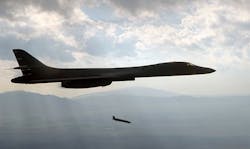Military researchers move forward with LRASM anti-ship missile project for next-gen naval munition
Officials of the U.S. Defense Advanced Research Projects Agency (DARPA) in Arlington, Va., announced a $104.3 million contract modification this week to the Lockheed Martin Missiles and Fire Control segment in Orlando, Fla., for the Long Range Anti-Ship Missile (LRASM) Accelerated Acquisition program.
Tuesday's contract modification raises the total cumulative face value of the contract from $202.6 million to $306.9 million, DARPA officials say.
Lockheed Martin will use the additional money to prepare an experimental advanced anti-ship missile for acquisition within the next three years for use on the U.S. Navy F/A-18E/F Super Hornet fighter bomber, as well as the U.S. Air Force B-1B Lancer supersonic bomber.
DARPA is asking Lockheed Martin to make the program ready for a planned acquisition in 2017 for LRASM munitions that can be launched from the carrier-based Super Hornet jet and the land-based Lancer bomber.
Lockheed Martin has been designing LRASM for the last six years under DARPA supervision. The advanced anti-ship missile is intended to replace the ageing Harpoon anti-ship missile.
The LRASM will use on-board targeting systems to acquire the target independently without the presence of prior, precision intelligence, or supporting services like Global Positioning Satellite navigation and data-links. The missile will be designed with advanced counter-countermeasures to evade hostile active defense systems.
The missile is being designed to fire from the Mk 41 Vertical Launch System aboard Navy surface warships, from the B-1B, and from the F/A-18E/F. Submarine-launched versions are under consideration. The program is scheduled to switch from DARPA to the Navy as early as next year.
DARPA is asking Lockheed Martin to mature LRASM systems and technology in preparation for completing the LRASM demonstration phase and move the weapon system into production.
Lockheed Martin will continue developing the LRASM long-range targeting sensor, as well as the long-range sensor algorithms and software for advanced LRASM capability against specific high-priority targets in densely spaced groups of surface ships.
Company missile experts also will work on the LRASM missile-control unit to optimize processor throughput margin and address hardware obsolescence. Lockheed Martin also will refine the LRASM electro-optical terminal target sensor hardware software to demonstrate the missile's ability in poor visibility.
After that, Lockheed Martin engineers will work on missile autonomy, and mature LRASM situational awareness software. Finally, company experts will refine the LRASM's weapon data link to meet U.S. Navy requirements.
The contract modification also funds Lockheed Martin engineers to integrate LRASM software with prototype sensor, guidance, and control hardware for extensive testing in a hardware-in-the-loop laboratory. The company also will develop and test the LRASM warhead fuze to address obsolescence and Navy insensitive-munitions issues.
Lockheed Martin also will conduct additional LRASM flight tests against surrogate targets from the Navy, with an eye to deploying LRASM on the Air Force B-1B bomber in 2018, and on the Navy F/A-18 carrier-based combat jet in 2019.
In fall 2014 Lockheed Martin conducted its second LRASM flight test in a launch from an Air Force B-1B bomber off the Southern California coast. Flying over the sea range at Point Mugu, Calif., a the B-1B bomber from the 337th Test and Evaluation Squadron at Dyess Air Force Base, Texas, released the LRASM, which navigated through all planned waypoints receiving in-flight targeting updates from the system's Weapon Data Link, Lockheed Martin officials say.
Related: Lockheed Martin moves closer to demonstrating Long Range Anti-Ship Missile (LRASM)
After switching to autonomous guidance, the LRASM identified the target using inputs from the onboard sensors, descended for final approach, verified the target, and hit it.
The Lockheed Martin LRASM has a 1,000-pound penetrator and blast-fragmentation warhead, multi-mode sensor, weapon data link, and enhanced digital anti-jam global positioning system to detect and destroy selected surface targets within groups of ships.
Lockheed Martin is in charge of LRASM overall development, and the BAE Systems Electronic Systems segment in Nashua, N.H., is developing the LRASM onboard sensor systems. The Office of Naval Research (ONR) in Arlington, Va., also has been involved in LRASM development.
The DARPA LRASM contract is in response to a gap in Navy anti-ship missile technology identified in 2008. The standard Navy anti-ship missile is the subsonic Harpoon, which has been in the inventory since 1977.
On this contract Lockheed Martin will do its work in Orlando, Fla., and Troy, Ala. Lockheed Martin team members BAE Systems will do its work in Nashua, N.H.; Harris Corp. in Melbourne, Fla.; Northrop Grumman in Linthicum, Md. Ball Aerospace in Westminster, Colo.; and Williams Corp. in Walled Lake, Mich. The work will be finished by July 2016.
For more information contact Lockheed Martin Missiles and Fire Control online at www.lockheedmartin.com/us/mfc, or DARPA at www.darpa.mil.
